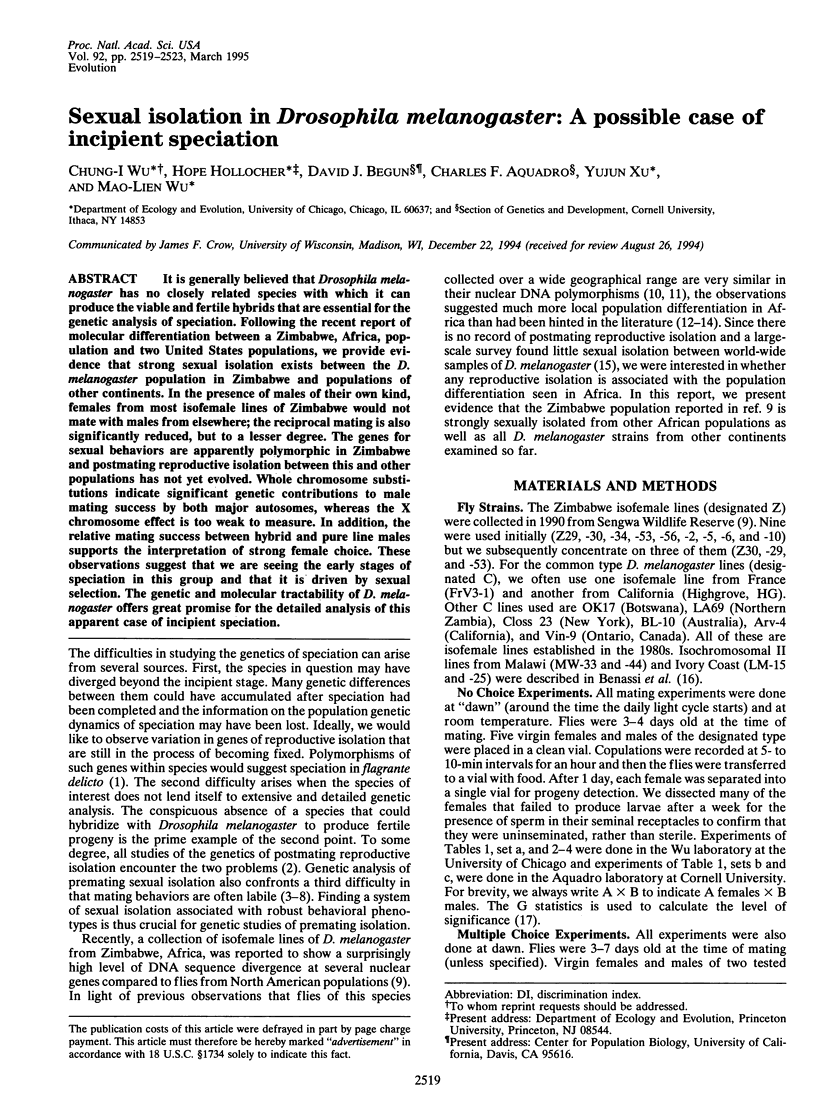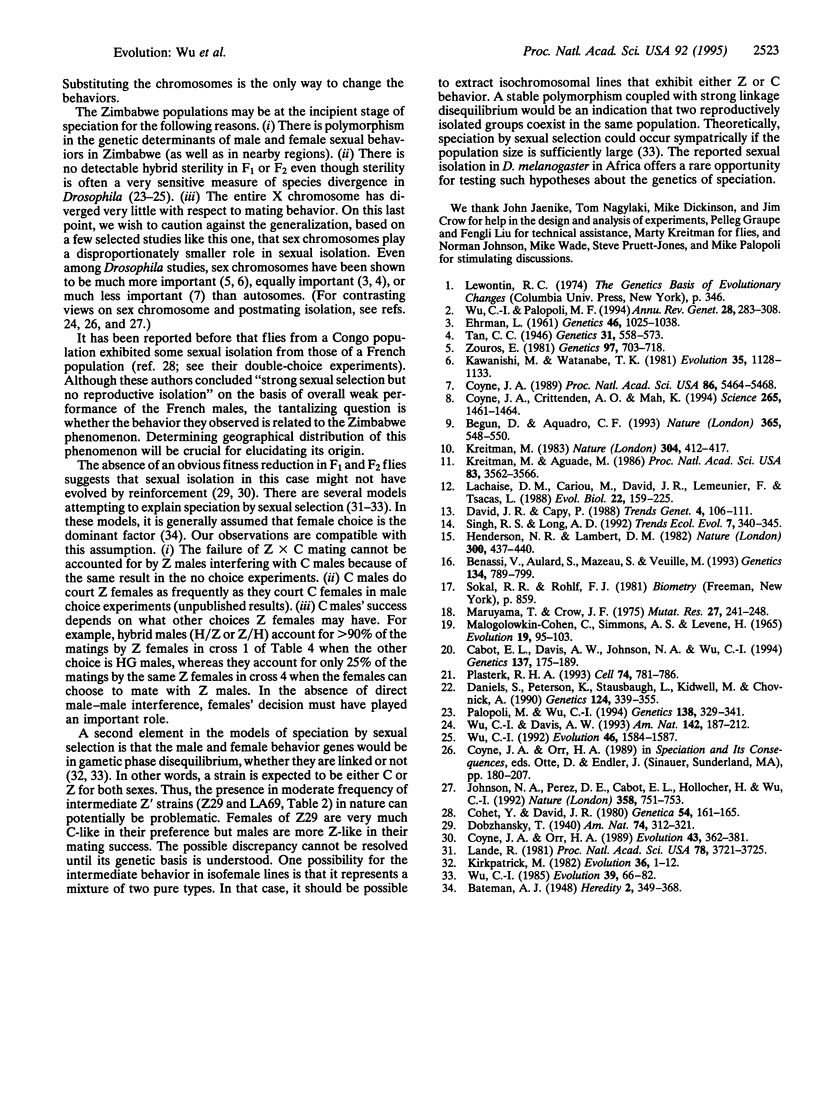Abstract
It is generally believed that Drosophila melanogaster has no closely related species with which it can produce the viable and fertile hybrids that are essential for the genetic analysis of speciation. Following the recent report of molecular differentiation between a Zimbabwe, Africa, population and two United States populations, we provide evidence that strong sexual isolation exists between the D. melanogaster population in Zimbabwe and populations of other continents. In the presence of males of their own kind, females from most isofemale lines of Zimbabwe would not mate with males from elsewhere; the reciprocal mating is also significantly reduced, but to a lesser degree. The genes for sexual behaviors are apparently polymorphic in Zimbabwe and postmating reproductive isolation between this and other populations has not yet evolved. Whole chromosome substitutions indicate significant genetic contributions to male mating success by both major autosomes, whereas the X chromosome effect is too weak to measure. In addition, the relative mating success between hybrid and pure line males supports the interpretation of strong female choice. These observations suggest that we are seeing the early stages of speciation in this group and that it is driven by sexual selection. The genetic and molecular tractability of D. melanogaster offers great promise for the detailed analysis of this apparent case of incipient speciation.
Full text
PDF




Selected References
These references are in PubMed. This may not be the complete list of references from this article.
- Begun D. J., Aquadro C. F. African and North American populations of Drosophila melanogaster are very different at the DNA level. Nature. 1993 Oct 7;365(6446):548–550. doi: 10.1038/365548a0. [DOI] [PubMed] [Google Scholar]
- Bénassi V., Aulard S., Mazeau S., Veuille M. Molecular variation of Adh and P6 genes in an African population of Drosophila melanogaster and its relation to chromosomal inversions. Genetics. 1993 Jul;134(3):789–799. doi: 10.1093/genetics/134.3.789. [DOI] [PMC free article] [PubMed] [Google Scholar]
- Cabot E. L., Davis A. W., Johnson N. A., Wu C. I. Genetics of reproductive isolation in the Drosophila simulans clade: complex epistasis underlying hybrid male sterility. Genetics. 1994 May;137(1):175–189. doi: 10.1093/genetics/137.1.175. [DOI] [PMC free article] [PubMed] [Google Scholar]
- Coyne J. A., Crittenden A. P., Mah K. Genetics of a pheromonal difference contributing to reproductive isolation in Drosophila. Science. 1994 Sep 2;265(5177):1461–1464. doi: 10.1126/science.8073292. [DOI] [PubMed] [Google Scholar]
- Coyne J. A. Genetics of sexual isolation between two sibling species, Drosophila simulans and Drosophila mauritiana. Proc Natl Acad Sci U S A. 1989 Jul;86(14):5464–5468. doi: 10.1073/pnas.86.14.5464. [DOI] [PMC free article] [PubMed] [Google Scholar]
- Daniels S. B., Peterson K. R., Strausbaugh L. D., Kidwell M. G., Chovnick A. Evidence for horizontal transmission of the P transposable element between Drosophila species. Genetics. 1990 Feb;124(2):339–355. doi: 10.1093/genetics/124.2.339. [DOI] [PMC free article] [PubMed] [Google Scholar]
- David J. R., Capy P. Genetic variation of Drosophila melanogaster natural populations. Trends Genet. 1988 Apr;4(4):106–111. doi: 10.1016/0168-9525(88)90098-4. [DOI] [PubMed] [Google Scholar]
- EHRMAN L. The genetics of sexual isolation in Drosophila paulistorum. Genetics. 1961 Aug;46:1025–1038. doi: 10.1093/genetics/46.8.1025. [DOI] [PMC free article] [PubMed] [Google Scholar]
- Johnson N. A., Perez D. E., Cabot E. L., Hollocher H., Wu C. I. A test of reciprocal X-Y interactions as a cause of hybrid sterility in Drosophila. Nature. 1992 Aug 27;358(6389):751–753. doi: 10.1038/358751a0. [DOI] [PubMed] [Google Scholar]
- Kreitman M., Aguadé M. Genetic uniformity in two populations of Drosophila melanogaster as revealed by filter hybridization of four-nucleotide-recognizing restriction enzyme digests. Proc Natl Acad Sci U S A. 1986 May;83(10):3562–3566. doi: 10.1073/pnas.83.10.3562. [DOI] [PMC free article] [PubMed] [Google Scholar]
- Lande R. Models of speciation by sexual selection on polygenic traits. Proc Natl Acad Sci U S A. 1981 Jun;78(6):3721–3725. doi: 10.1073/pnas.78.6.3721. [DOI] [PMC free article] [PubMed] [Google Scholar]
- Maruyama T., Crow J. F. Heterozygous effects of x-ray induced mutations on viability of Drosophila melanogaster. Mutat Res. 1975 Feb;27(2):241–248. doi: 10.1016/0027-5107(75)90083-4. [DOI] [PubMed] [Google Scholar]
- Palopoli M. F., Wu C. I. Genetics of hybrid male sterility between drosophila sibling species: a complex web of epistasis is revealed in interspecific studies. Genetics. 1994 Oct;138(2):329–341. doi: 10.1093/genetics/138.2.329. [DOI] [PMC free article] [PubMed] [Google Scholar]
- Tan C. C. Genetics of Sexual Isolation between DROSOPHILA PSEUDOOBSCURA and DROSOPHILA PERSIMILIS. Genetics. 1946 Nov;31(6):558–573. doi: 10.1093/genetics/31.6.558. [DOI] [PMC free article] [PubMed] [Google Scholar]
- Wu C. I., Palopoli M. F. Genetics of postmating reproductive isolation in animals. Annu Rev Genet. 1994;28:283–308. doi: 10.1146/annurev.ge.28.120194.001435. [DOI] [PubMed] [Google Scholar]
- Zouros E. The chromosomal basis of sexual isolation in two sibling species of Drosophila: D. arizonensis and D. mojavensis. Genetics. 1981 Mar-Apr;97(3-4):703–718. doi: 10.1093/genetics/97.3-4.703. [DOI] [PMC free article] [PubMed] [Google Scholar]


